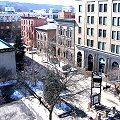- By -Staff
- Business & Technology
 Print
Print  Downtown Ithaca is one of ten U.S. communities to win a competitive application process that will result in a 2010 visit to the City of Ithaca, by an interdisciplinary group of national professionals from the American Institute of Architects (AIA), Sustainable Design Assessment Team. (SDAT) The application was submitted by the Downtown Ithaca Alliance
Downtown Ithaca is one of ten U.S. communities to win a competitive application process that will result in a 2010 visit to the City of Ithaca, by an interdisciplinary group of national professionals from the American Institute of Architects (AIA), Sustainable Design Assessment Team. (SDAT) The application was submitted by the Downtown Ithaca AllianceThe AIA’s SDAT program is a competition-based, annual community assistance program that focuses on the principles of sustainability. It brings teams of professionals such as architects, urban designers, landscape architects, transportation, downtown, development and economic planners, landscape architects, hydrologists, and others to work with community decision-makers and stakeholders to help them develop a vision and framework for a sustainable future.
The Downtown Ithaca Alliance's application proposed to undertake an analysis of connections between downtown Ithaca and surrounding commercial and activity centers, such as Collegetown/Cornell University, the West End/Inlet Island area, and Ithaca College. The emerging downtown Ithaca 2020 strategic plan calls for an emphasis on improving and enhancing links between downtown and its commercial district neighbors.
The Ithaca project will be collaboration between the Downtown Ithaca Alliance, the City of Ithaca, the Southern Tier AIA Chapter, The Tompkins County Convention and Visitors Bureau, Cornell University, Ithaca College, and TC3, as well as representatives from Collegetown and the West End/Inlet Island. Meetings will be held with the community throughout the week, culminating in a presentation of recommendations and the preparation of a written report for the community
Downtown Ithaca Alliance Executive Director Gary Ferguson says, "We’re honored that the AIA’s Sustainable Design Assessment Team Program chose Ithaca as one of the cities it will visit in 2010. This project will enable us to begin examining how downtown links with its neighbors."
There are several components to the AIA SDAT community assistance program, including a preliminary visit, a three-day visit from the multidisciplinary team, a report highlighting strengths and weaknesses regarding sustainability and recommendations for overcoming obstacles, ongoing consultations and a follow up visit.
The SDAT process helps communities:
- understand their structure at various scales and contexts;
- explore interactions between ecological, sociological, economic, and physical systems;
- visualize potential futures;
- articulate the qualities of a place;
- advance the principles of sustainable communities; and
- define the role of stakeholders and players in both the public and private sectors.
----
v5i49




